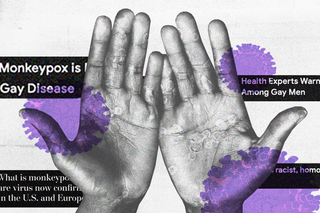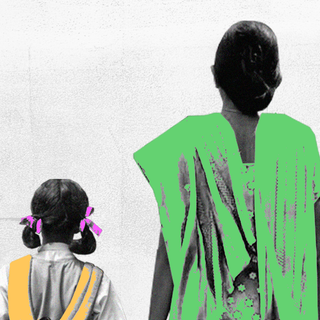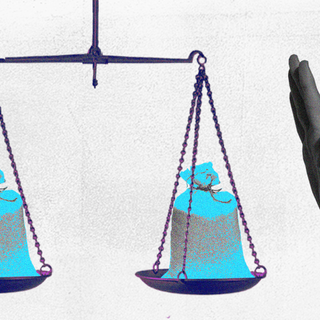
Global Media Coverage of Monkeypox is Rooted in Racism, Homophobia
Activists urge the media to refrain from using stock images bearing persons of black, dark, and African skin complexion to depict the outbreak.

It is a myth only now beginning to be debunked that health crises are rarely discriminatory. It is the ultimate reminder of human mortality that dawns upon people equally. The pandemic was only the latest reminder to illustrate how untrue this is: marginalized communities have always shouldered a disproportionate impact of any infectious disease or illness. The latest monkeypox outbreak in some countries once again stokes this under–appreciated truth. The narrative Westernmedia is constructing around the virus is one of tacit blame and stigma along the lines of race and gender.
Over the last few weeks, countries like the U.S., U.K., Australia, and Canada have reported a spate of cases of monkeypox in their countries. A relative of the smallpox family, monkeypox occurs mostly in remote parts of central and west African countries, near tropical rainforests, and has two different strains. Yet, the most recent cases that are being detected have no history of travel, no contact with someone who had monkeypox; some cases in the U.K. even seem to be the result of community spread.
To a discerning eye, what we know so far is there is an outbreak in countries where the virus is not endemic. However, the media reporting on the virus and infected individuals have carried shades of blatant discrimination and bigotry.
Right now, monkeypox is among the most searched query on Google, and a quick glimpse will show pictures of Black patients mostly from Central and Western Africa. The Foreign Press Association, Africa, pointed out the racism in the way news coverage has played out. “As any other disease, it can occur in any region in the world and afflict anyone, regardless of race or ethnicity. As such, we believe that no race or skin complexion should be the face of this disease,” they wrote in a letter. “It is therefore disturbing for European and North American media outlets to use stock images bearing persons with dark/black and African skin complexion to depict an outbreak of the disease in the United Kingdom and North America.”
The defense of some media outlets seems to be that since monkeypox is endemic to some regions in Africa, Google and other stock images outlets use would end up being of people from those regions. There remains something amiss in this line of argument: logistically, if the outbreak is in Europe or America, why shouldn’t the organizations take images from the ground, documenting the condition of those hospitals? If this reporting is about convenience, it makes for lousy journalism. One of my favorite responses to this hypocrisy was: “So the present outbreak has victims who are prone to photophobia? Let the journalists get pictures from hospitals currently treating cases in the outbreak countries.”
The impact is far from innocuous in a socio-political context: “We condemn the perpetuation of this negative stereotype that assigns calamity to the African race and privilege or immunity to other races,” FPA noted. “We find these actions to be very insensitive… Is the media in the business of ‘preserving White purity’ through ‘Black criminality or culpability’?” Arguably, the racist undertones also suppress the empathy and nuance that Black and brown-skinned people deserve. It relies on an age-old stereotype: black and brown people as reservoirs and vectors of disease; white people as hapless victims.
Related on The Swaddle:
Omicron Variant Did Not ‘Originate’ in South Africa, It Was ‘Detected’ There. The Difference Matters
Even the reporting of cases among people from the LGBTI+ community is couched in homophobia. The trend so far, reportedlyis a fair share of cases are being seen in gay, bisexual men, and men who have sex with other men in the U.K. and Europe. This, however, fits into the larger picture that literally anyone in close contact with a monkeypox patient could potentially contract the virus, and the narrative reinforces stereotypes and amplifies stigma against the condition itself.
Any and every stigmatizing language around monkeypox, and the host of diseases that have preceded and will come after, doesn’t just affect the communities in question — it jeopardizes public health. “Experience shows that stigmatizing rhetoric can quickly disable evidence-based response by stoking cycles of fear, driving people away from health services, impeding efforts to identify cases, and encouraging ineffective, punitive measures,” a statement by the UNAIDS pointed out.
This is not dissimilar to the reckless way information was communicated during the multiple waves of the Covid19 pandemic. The public health misinformation played in 2020 and then again in 2021, when people insisted on calling B.1.1.529 the “South African variant,” perpetuating a cycle of racism and xenophobia. In India too, early waves of the pandemic were blamed on the Tablighi Jamaat, a Muslim community that was demonized by the media and the public for purportedly spreading Covid19.
The discrepancy relays how the “racist” trope self-fulfills itself. The media was also complicit in framing a homophobic response to the HIV/Aids crisis that blazed through London in the 1980s. Through words and images, people living with HIV were framed as the menacing “other.” “Most of the rather sensational reporting … was around contagion, around gay men, about excluding them and herding them up,” one doctor noted. The coverage leverages underlying anxiety and prejudice in society to stoke tides of fear and hate.
Here’s what we know about the condition so far. Symptoms include fever, muscle aches, and swollen lymph nodes; this coupled with chickenpox-like rashes are also found on the hands and face. Transmission happens due to close contact with infected animals such as monkeys and rodents, according to WHO. People can spread it by way of contact with body fluids, monkeypox sores, or shared items (such as clothing and bedding) that have been contaminated with fluids or sores of a person with monkeypox. The infection usually clears up on its own and lasts between 14 and 21 days.
The precautionary advice is one we are familiar with: isolation for 21 days, in addition to foregoing travel and community tracing.
Race, gender, ethnicity, caste, class — any and every marker of one’s identity — change the way someone experiences and negotiates with healthcare. Monkeypox is not unique in the way its coverage has unfolded, but there remains time to correct the brashness and prejudice.
Saumya Kalia is an Associate Editor at The Swaddle. Her journalism and writing explore issues of social justice, digital sub-cultures, media ecosystem, literature, and memory as they cut across socio-cultural periods. You can reach her at @Saumya_Kalia.
Related


Kerala’s Proposal To Form ‘Mother PTAs’ in Schools Draws Flak for Reinforcing Sexist Stereotypes
